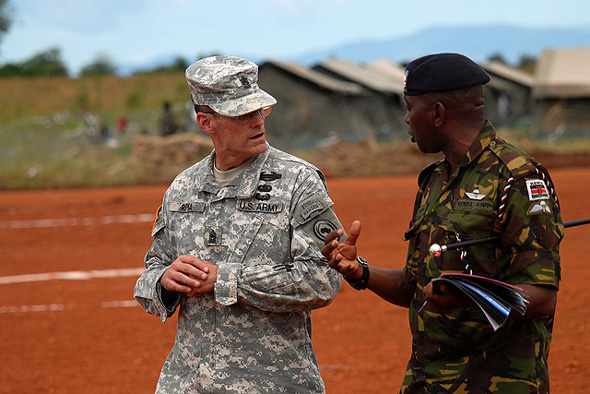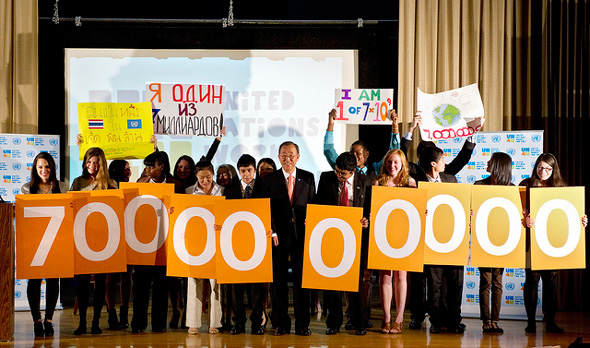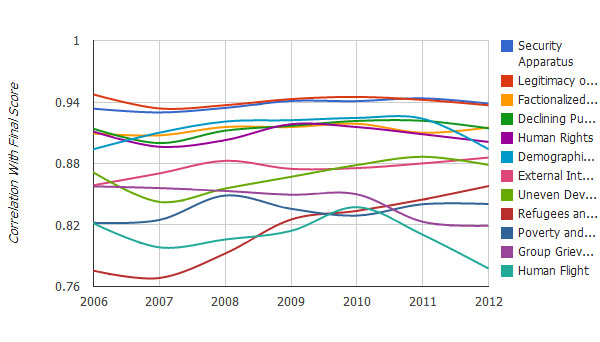-
Should AFRICOM Leave Development to the Professionals?
›August 30, 2012 // By Schuyler Null
Since its inception, there’s been a great deal of prognostication about the role and goals of the U.S. military’s newest regional command, AFRICOM. The smallest of the six regional commands, in terms of staff and budget, its objectives have included traditional roles like building local military capacities, confronting transnational threats (terrorism, weapons of mass destruction, small arms, drugs, etc.), and helping to mitigate violent conflicts, but also more development-oriented goals, like fighting HIV/AIDs and malaria, “strengthening democratic principles,” and “fostering the conditions that lead to a peaceful, stable, and economically strong Africa.”
-
Geoff Dabelko on the Evolution of Integrated Development and PHE
›August 27, 2012 // By Schuyler Null“Population-health-environment [PHE] connections have really been a focus of ours here at the Wilson Center for the last 15 years,” said outgoing ECSP Director Geoff Dabelko in an interview at the Wilson Center. The goal of ECSP’s project – HELPS (health, environment, livelihoods, population, and security) – is “really trying to understand these issues together.”
-
Another Year, Another Debate: Is the Failed States Index Simply Misnamed?
›
Every year, there are mixed reactions over the rankings and the efficacy of the Fund for Peace’s Failed States Index (FSI), the eighth edition of which was released in June. But this year, the criticism seems especially intense.
“Failed means there is no way back. Failed means a binary division between those countries that are salvageable and those beyond redemption. It is a word reserved for marriages and exams. It does not belong in a pragmatic debate,” wrote Claire Leigh for The Guardian in June.
-
Top 10 Posts for July 2012
›Kate Diamond’s look at Mongolia’s nexus of climate, development, and extractive industry issues ran away with the top spot last month (measured by unique pageviews) and was joined by a host of newcomers. We updated you on Afghanistan’s mineral potential and continuing maternal health issues; reviewed CAP’s climate-migration report, CCAPS’s climate-conflict mapping tool, and David Bonnardeaux’s treatise on integrated development in Africa; and examined some of USAID’s recent open data initiatives and what they might signal for the agency moving forward.
1. In Mongolia, Climate Change and Mining Boom Threaten National Identity
2. India’s Maoists: South Asia’s “Other” Insurgency
3. Eye On: Visualizing Complex Vulnerability in Africa: The CCAPS Climate-Conflict Mapping Tool
4. Center for American Progress Takes on Climate Change, Migration, and Why They Matter to U.S. National Security
5. Eye On: New USGS Report and Maps Highlight Afghanistan’s Mineral Potential, But Obstacles Remain
6. Book Review: ‘World Population Policies’ Offers Sweeping Overview of a Complex Field
7. Dot-Mom: ‘Motherland Afghanistan’ Shows Maternal Mortality Not Just A Health Issue
8. Open Data Initiatives at USAID Reflect Move Towards Collaboration, Enabling Efforts
9. In Search of a New Security Narrative: The National Conversation Series Launches at the Wilson Center
10. Beat on the Ground: Linking Water, Sanitation, and Biodiversity Conservation in Sub-Saharan Africa -
World Population Day 2012: Looking Beyond Reproductive Health
›How should the seven billion or so of us on Earth mark World Population Day? Today, major global players are focusing on increasing access to family planning around the world. But there are other important aspects to population that also deserve our sustained attention.
The links between demography and development have come into the limelight over the last few months, first as advocates decried the last minute removal of reproductive rights language from the Rio+20 outcome document and now as the Bill and Melinda Gates Foundation prepares a massive funding push for reproductive health (starting today, not coincidentally).
“Multiple crises – food, fuel, and financial – have caused significant suffering and served as a wake-up call about the need to pay far more attention to the building blocks of sustainable development,” UN Secretary-General Ban Ki-moon says in an address for today. “Reproductive health is an indispensable part of the sustainable development equation.”
The sustainable development connection is fairly obvious. Environmental destruction in some of the most biodiversity-rich parts of the world has complex but significant population drivers, as Wilson Center consultant Laurie Mazur explains:Human impact on the environment is mediated by a host of factors, including culture, technology, institutions, and market forces. And inequitable socioeconomic systems mean that some human beings have far greater impact than others.
“Often, the value of biodiversity becomes apparent only when it is lost,” Mazur continues. “For example, with the global decline of honeybee populations, growers can now calculate the monetary value of pollination services that were once provided for free by nature. ‘Bee pollination is worth $190 billion,’ said Pavan Sukhdev, a Yale environmental economist, in an interview with Bloomberg. ‘But when did a bee ever send you an invoice?’”
But some generalizations can be made. We live on a planet dominated and transformed by human activity. As we have become more numerous, we have also become more adept at altering ecosystems for human use, replacing species-rich natural landscapes with simpler monocultures.
In other areas, population drivers threaten more basic scarcities: food and water, which in turn impede development and cost human lives. Some of the most successful efforts to address these relationships have combined women’s empowerment, family planning, and basic health interventions with site-based conservation and livelihood efforts.
But besides reproductive rights, there are other important aspects of population that deserve attention on this day.
The demographic dividend – a concept that marries population dynamics and development economics – requires more than just fertility decline to take effect in countries. Economic and social policies that prepare and enable young people to enter the workforce are just as important.
And the Arab Spring helps illustrate the complex relationship between population and democracy. “Among the five countries where revolt took root, those with the earliest success in ousting autocratic leaders also had the most mature age structures and the least youthful populations,” writes Wilson Center consultant and demographer Elizabeth Leahy Madsen. The work of fellow Wilson Center consulting demographer Richard Cincotta shows that countries with very young age structures are prone both to higher incidence of civil conflict and undemocratic governance. What happens next in Egypt, Libya, Yemen, and Syria will further test the connection between youth and democracy.
In South Asia, Madsen finds that as Afghanistan and Pakistan’s political circumstances have become more entwined, their demographic paths are more closely parallel than expected. “For Afghanistan, given its myriad socioeconomic, political, cultural, and geographic challenges, this is good news. But for Pakistan, where efforts to meet family planning needs have fallen short of capacity, it is not,” she writes in the first issue of the newly re-launched ECSP Report, “Afghanistan, Against the Odds: A Demographic Surprise.”
In more developed countries, population aging is a concern. At the Wilson Center last year, economists Andrew Mason and Ronald Lee explained the challenges that those on the other side of the “demographic divide” will face in the near future. From 2010 to 2015, 85 countries are projected to witness the largest absolute increase in history of their populations aged 60 and over, straining public welfare systems and reducing labor forces. It’s not the “catastrophe” that it has been portrayed to be in the media, they said, but like many demographic issues, it is a challenge that will require planning for.
These connections demonstrate the wide importance of population dynamics to understanding how the world works today. Demography is the study of us – all seven billion of us. Demography affects – and is affected by – economics, political stability, health, the environment, food security, foreign policy, development, and conflict. Let’s not overlook that breadth on this World Population Day 2012.
For more, be sure to read some of our additional resources from the recent archives:- Food Security in a Climate-Altered Future: More Than a Supply Problem
- Taming Hunger in Ethiopia: The Role of Population Dynamics
- Uganda’s Demographic and Health Challenges Put Into Perspective With Newfound Oil
- New Surveys Generate Mixed Demographic Signals for East and Southern Africa
- In Building Resilience for a Changing World, Reproductive Health Is Key
- Demographic Security 101 (video)
- Yemen: Revisiting Demography After the Arab Spring
- Hania Zlotnik Discusses Latest Changes to UN Population Projections (audio)
- Book Review: ‘World Population Policies’
- Tunisia’s Shot at Democracy: What Demographics and Recent History Tell Us
- Joel E. Cohen on Solving the Resource-Population Equation in the Developing World (video)
Photo Credit: UN Day Secretary-General Ban Ki-moon with students in October celebrating the seven billion mark, courtesy of Eskinder Debebe/UN Photo. -
Top 10 Posts for June 2012
›With the focus on sustainable development last month, Rio+20 coverage and related-population, health, and environment stories crept into the top posts (measured by unique pageviews). Carl Haub of Population Reference Bureau made a surprise appearance too with his update on the Democratic Republic of Congo’s latest demographic and health survey coming in at number three. To read ECSP’s full coverage of the 20th anniversary of the UN Earth Summit, see a full line-up of posts from Sandeep Bathala and our partners here.
1. India’s Maoists: South Asia’s “Other” Insurgency
2. The Year Ahead in Political Demography: Top Issues to Watch
3. Republic of Congo Demographic and Health Survey Shows High Maternal Health, But No Fertility Decline
4. In Search of a New Security Narrative: The National Conversation Series Launches at the Wilson Center
5. Reading Radar: USAID’s New Global Health Framework and Delivering Equity in Health Interventions
6. Guest Contributor Tim Hanstad: Poor Land Tenure: A Key Component to Why Nations Fail
7. Pop at Rio+20: Getting Women’s Rights on the Agenda
8. Bringing Environment and Climate to the 2012 Population Association of America Annual Meeting
9. On the Beat: Sex and Sustainability on the Road to Rio+20
10. PHE and Community-Based Adaptation to Climate Change: Stronger Together -
What Are the Most Important Factors in the Failed States Index?
›Last week, the Fund for Peace issued its eighth annual Failed States Index (FSI). The index gives 177 countries a score between 1.0 and 10.0 for 12 indicators, ranging from the legitimacy of the state and the security apparatus to demographic pressure and uneven development (high being bad, low being good – see full descriptions of the indicators here). But which of these indicators has the biggest impact? We did a quick analysis of the Failed States Indexes published from 2006 to 2012 to show which of the indicators correlate most with a high score. (We skipped 2005 since the roster of analyzed countries was significantly smaller.)
-
Top 10 Posts for May 2012
›Laurie Mazur, Elizabeth Leahy Madsen, Tim Hanstad, and Musimbi Kanyoro topped the list last month. Integrated looks at development and security issues were popular in general, with looks at hotspots like Nigeria, Uganda, Yemen, Pakistan, Ethiopia, and India, and topics like land and water security all represented in the top 10.
1. Taming Hunger in Ethiopia: The Role of Population Dynamics
2. India’s Maoists: South Asia’s “Other” Insurgency
3. Yemen: Revisiting Demography After the Arab Spring
4. Guest Contributor Tim Hanstad: Poor Land Tenure: A Key Component to Why Nations Fail
5. Guest Contributor Musimbi Kanyoro: Women’s Rights and Voices Belong at Rio+20
6. The Global Water Security Assessment and U.S. National Security Implications
7. Uganda’s Demographic and Health Challenges Put Into Perspective With Newfound Oil Discoveries
8. Nabeela Ali on How PAIMAN Is Improving Maternal Health in Pakistan
9. In Search of a New Security Narrative: The National Conversation Series Launches at the Wilson Center
10. Nigeria Beyond the Headlines: Demography and Health [Part One]
Showing posts by Schuyler Null.







